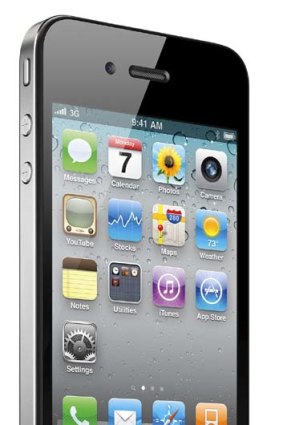By Harold Mitchell
AUSTRALIA is one of 20 or so countries that has more mobile phones than people - about 24 million phones for a population of 22 million.
And the mad phone disease has reached epidemic proportions in Thailand, with figures showing eight phones per person. A lot, but the stats come from Wikipedia and it has got most things right recently.

The Apple iPhone 4.
About 20 years ago, the mobile phone was called "the brick", but Charlie's first phone that didn't have to be plugged into a wall was an even earlier contraption. It was more like a field telephone and he carried it around in a bag. But this year, 70 per cent of new mobile phones are smartphones and that's a big increase from 57 per cent in 2010, and probably rising to 80 per cent within three years.
The leading smartphone in Australia is the Apple iPhone, although it has plenty of competitors. Louise says that there is a need to define what a smartphone is. Her thinking is that a smartphone is a phone that is smarter than its owner. That's a bit unkind, but she did have real trouble this week trying to work her way through the 333,214 free and paid apps on offer.
For those of us who still just use a phone to make phone calls, I should point out that an "app" is slang for application software that allows a "phone" to become this newspaper or a global position locator, even a speech translator. It's a new period of telecommunications.
And it's not an age thing. Louise, who is a woman of a certain age, says smartphones aren't just for Generation Y. One in five smartphone owners is aged over 50, and 40 per cent are over 40. It's also a bit of a male thing, with 43 per cent of owners male and 31 per cent female.
Charlie tells me that these smartphones are so clever that the US Army is now thinking that "coms" in the wilds of Afghanistan could be enhanced if every soldier had an iPhone. So much for the hundreds of millions that the Western defence forces have spent on satellite communications over the decades, only to be bettered by some clever people on America's west coast.
Last week, I wrote about the growth of Asian economies, particularly China and India. While we might think that America is the home market for the mobile phone, with about 300 million of the 5 billion devices worldwide, the figures for April show a staggering take-up in Asia. China has just on 900 million, nearly three times the number in the US, and India's mobiles number more than 800 million.
Many Australians are accessing the internet from their smartphones daily, and more frequently than they do via their computers. So, if you're in the advertising business, it makes sense to be connected to a mobile phone company and learn to use the devices to the limit. It's no more difficult than learning Mandarin - something we all should do as well. The amount of money advertisers spend on mobiles at the minute is minuscule, but research firm Frost and Sullivan estimates that the mobile advertising medium will grow from about $10 million a year to nearly $46 million by 2015.
We used to think that television was the big thing in marketing. And then it was the internet. But stand back for the coming age of the clever little thing in your pocket. It almost seems silly to call it a telephone.
Harold Mitchell is executive chairman of Mitchell Communication Group.